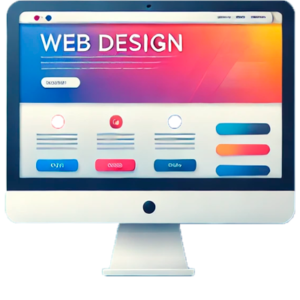Web Design: Essential Principles for Building User-Friendly Websites

In the digital age, a well-designed website is more than just an online presence; it’s the cornerstone of any successful business, brand, or project. A user-friendly website not only attracts visitors but also keeps them engaged, builds trust, and drives conversions. In this guide, we’ll explore the essential principles of web design that will help you create a website that’s visually appealing, functional, and optimized for user experience (UX).
Table of Contents
The List of 10 Items for Building a User Friendly Website
1. Understand Your Audience
Before you start designing, it’s crucial to know who you’re designing for. Understanding your target audience will guide every decision, from layout to content.
How to Identify Your Audience:
Demographics: Age, gender, location, and occupation.
Interests and Needs: What problems are they trying to solve?
Behavior: How do they interact with websites? What devices do they use?
Tailor your design to meet these needs. For instance, if your audience includes older adults, prioritize larger fonts and simple navigation.
2. Prioritize Mobile-First Design
With over half of global web traffic coming from mobile devices, designing for mobile-first is no longer optional.
Key Mobile Design Strategies:
Responsive Design: Ensure your website adjusts seamlessly to different screen sizes.
Simplified Navigation: Use hamburger menus and easy-to-tap buttons.
Fast Loading Times: Optimize images and minimize code to enhance speed.
Google’s mobile-first indexing makes this principle even more critical for SEO.
3. Focus on Visual Hierarchy
Visual hierarchy refers to the arrangement of elements to guide users’ attention to what matters most.
Tips for Effective Visual Hierarchy:
Size and Scale: Use larger fonts for headlines and smaller fonts for supporting text.
Color and Contrast: Highlight important elements with contrasting colors.
Whitespace: Give elements room to breathe, improving readability.
A clear visual hierarchy ensures users find what they’re looking for without frustration.
4. Simplify Navigation
Navigation is the backbone of user experience. If users can’t find what they need quickly, they’re likely to leave your site.
Best Practices for Navigation:
Keep It Simple: Limit menu items to 5-7 options.
Use Descriptive Labels: Avoid vague terms like “Stuff” or “More.”
Include a Search Bar: For larger websites, a search function is essential.
Breadcrumbs and clear CTAs (Call-to-Actions) further enhance usability.
5. Optimize for Speed
Website speed directly impacts user satisfaction and SEO rankings. A slow-loading website can deter users, leading to higher bounce rates.
How to Improve Loading Speed:
Compress Images: Use tools like TinyPNG to reduce file sizes.
Minimize HTTP Requests: Combine CSS and JavaScript files.
Enable Browser Caching: Store website data locally to speed up repeat visits.
Aim for a loading time of under 3 seconds to retain users.
6. Create Accessible Designs
Accessibility ensures that your website is usable by everyone, including people with disabilities. It’s not just ethical; it’s also a legal requirement in many jurisdictions.
Accessibility Guidelines:
Alt Text for Images: Describe images for screen readers.
Keyboard Navigation: Ensure all functionality is accessible via keyboard.
Color Contrast: Use sufficient contrast between text and background colors.
Following the Web Content Accessibility Guidelines (WCAG) ensures inclusivity.
7. Use Consistent Branding
Your website should reflect your brand identity, creating a cohesive experience for users.
Elements of Consistent Branding:
Logo Placement: Typically in the top-left corner, linking back to the homepage.
Color Scheme: Use a consistent palette across all pages.
Typography: Limit font choices to 2-3 to maintain visual harmony.
Consistency builds trust and recognition among users.
8. Write Engaging and SEO-Friendly Content
Content is king, but it’s only effective when it’s engaging and optimized for search engines.
Content Writing Tips:
Use Headlines and Subheadings: Break content into digestible sections.
Incorporate Keywords Naturally: Avoid keyword stuffing.
Write for Humans First: Prioritize readability and value over algorithms.
Tools like Yoast SEO can help ensure your content meets optimization standards.
9. Incorporate Effective Calls-to-Action (CTAs)
CTAs guide users toward desired actions, whether it’s signing up for a newsletter or making a purchase.
Designing Impactful CTAs:
Be Clear and Direct: Use action-oriented language like “Get Started” or “Learn More.”
Make Them Stand Out: Use contrasting colors and larger buttons.
Position Strategically: Place CTAs above the fold and at the end of pages.
A/B testing can help you refine your CTAs for maximum conversions.
10. Test and Iterate
Web design is an ongoing process. Regular testing and updates ensure your website remains user-friendly and competitive.
Testing Methods:
A/B Testing: Compare different versions of a page to see which performs better.
Heatmaps: Analyze where users click and scroll.
User Feedback: Conduct surveys or usability tests.
Use analytics tools like Google Analytics to track performance metrics and identify areas for improvement.
Conclusion
Building a user-friendly website is both an art and a science. By focusing on principles like mobile-first design, visual hierarchy, and accessibility, you can create a website that not only looks great but also performs exceptionally well. Remember, a successful website is one that serves its users effectively while achieving your business goals. Start implementing these principles today, and watch your website become a powerful tool for growth and engagement.
